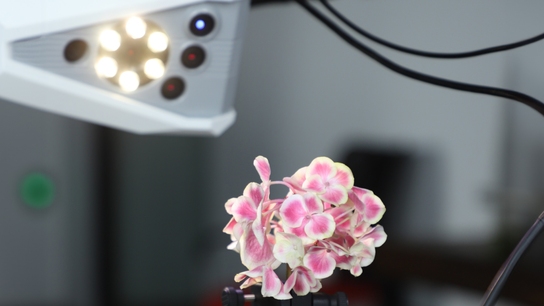Artec Eva helps unveil the cultural heritage of the Muisca civilization
Challenge: An archaeologist needed a faster and more precise way to digitally document an important site where the ancient Colombian Muisca civilization was being explored.
Solution: Artec Eva, Artec Studio
Result: With Artec Eva, an archaeology expert captured both the entire excavation site, as well as all of the objects within, in glorious 3D, providing the most accurate documentation of the site and digitizing the rarest Muisca artifacts for enhanced heritage management, education, and research.
The Muiscas, the indigenous people of Colombia, who once lived high in the Andes, gave the world the legend of El Dorado: When a new chieftain rose to power, he covered himself in gold dust and dived deep into Lake Guatavitá to pacify the underwater gods. As part of the ceremony, gold and precious gemstones like emeralds were thrown into the lake to please the gods, and to mark the beginning of the new chieftain’s rule.
Spanish explorers who arrived in the early 16th century gave the golden king the name El Dorado, “the gilded one.” In 1545, the Spaniards attempted to drain the lake, hoping to recover the fabulous treasure. What they found were hundreds of pieces of gold, which led them to believe there had once been a city of untold riches.
Preserving the pre-Hispanic heritage of Colombia
Beyond the fascinating stories of times past, the Muisca Empire as we know it today is just as mysterious and captivating. With plenty of relics and artifacts that continue to be discovered around modern-day Colombia, we are left in awe of their hierarchy in leadership, elaborate craft and trade practices, and their massive impact on Colombian culture.
Few people are aware that the Muisca Empire flourished for more than a thousand years, and was as advanced a civilization as the more well-known Inca, Maya, and Aztec civilizations. Centuries later, descendants of the Muiscas and local archaeologists are fighting an uphill battle to rescue, document, and preserve their heritage, which was put at great risk with the expansion of Bogotá, the Colombian capital.

Many of Muisca civilization artifacts have remained undiscovered for thousands of years
Just like this story of how ancient artifacts came to be digitally preserved using today’s technology, the high-altitude city of Bogotá, cradled by Andean peaks, is a unique fusion of past and present. Many impressive items of pre-Hispanic cultures are found in local museums, even as local researchers conduct ongoing studies in history, anthropology, and archaeology, to do their best to make up for the devastating effects of colonization.
While many businesses in the area have little interest in potential archaeological sites, local laws still oblige companies to be mindful of cultural heritage. The community was fortunate that one of the companies building a road near the capital, Perímetral Oriental de Bogotá, turned out to be very keen on recovering as much information about the area as possible, and for good reason: The site was nothing less than one of the four most important Muisca settlements in the Valley of Teusaca, the core area of the Southern Muisca chiefdom confederation.
Presented with the challenge of monitoring the site, the actual digging and digitizing of any findings, one innovative local archaeologist jumped at the chance.
An archaeologist with a vision
A graduate from the National University of Colombia, and a professional who keenly develops brand new approaches, Francisco Correa worked in close collaboration with Lina María Campos and Maria Alicia Uribe, curator and head of Museo Del Oro (Colombia’s dazzling Museum of Gold) respectively, to help document, analyze, and manage artifacts after this amazing set of archaeological contexts and ancient art was found. These objects are now proudly housed in the museum.
Correa and his team were instrumental in finding such unique Muisca relics as “ofrendatarios,” ceramic vessels serving as recipient of offerings to gods in burial ceremonies. And this time, they had access to an exciting new way to do it.
Traditionally, documenting work on any archaeological expedition would involve the use of rulers, strings, plotting paper, and a great deal of drawing by hand. Correa’s search for an alternative was based mainly on necessity: to save time and effort. So, he started experimenting from scratch with different methods such as photogrammetry and 3D modeling using photographic referencing.
When these were rendered insufficient to achieve the desirable precision and accuracy while dealing with extremely fragile artifacts, Correa got hold of Artec Eva – his very first 3D scanner, and a new tool that would change everything.

Francisco Correa scanning with Artec Eva out in the field
Artec Eva, famously used by archaeologists to scan Maya heritage for the British Museum and the remains of Homo Naledi in the Dinaledi Chamber in Africa, is a light and versatile 3D scanner, perfect for capturing medium-sized objects.

Traditional archaeology often relies heavily on manual measurements
Striving to achieve phenomenal accuracy and level of detail
With prior experience in 3D scanning and after additional training from the Artec support team, Correa headed straight into the field with Eva to scan the project site, bone remains, and artifacts found by his team. In no time at all, they realized that 3D scanning would mark the beginning of a new era in documenting archaeological contexts – and artifacts in Muisca archaeology.
“I think this digitization is needed because it delivers an excellent representation of the materials we work with,” Correa said. “It is wonderful for getting an accurate representation of osteological material, conveying information about the position of the bones with a level of detail that is hard to equal by any other means.”
An initial expedition aimed to recover all information possible about the area where the road construction was intended. As the story unfolded, however, the team started finding more and more unique evidence of the Muisca’s ritualistic behavior.
According to Correa, while all other objects they managed to find and carefully document in 3D – the ceramic vessels and metallic figurines, the seashells, the rings, the emeralds – have long been found all over the region, this turned out to be the first archaeological excavation in Colombia that discovered the aforementioned ofrendatarios – ceramic containers that held metallic figurines and emeralds, and were indicative of the Muisca’s burial traditions. Some of the vessels were found within the area of what are most likely the foundations of a sanctuary or a temple, opening a window to the world of religious rituals and the complex organization of Muisca society.
These discoveries also shine a light on the Muisca timeline. “We can determine what the most important Muisca period is, and if it corresponds with the time the Spaniards got into the island,” Correa said. “It’s a really important discovery.”


Fragments of ofrendatarios, ceramic vessels used in Muisca burial ceremonies
Steps and measures: 3D scanning as an invaluable asset for archaeologists
Over the next two and a half years, Correa and a small team supervised the technical aspects of the excavation. The process usually began by sitting down to prepare the necessary equipment for work – a laptop, Eva, and a battery were enough to start.
With Eva’s 100% safe, structured white light beaming down as they scanned, the team never worried about the technology inflicting any damage to the objects or anything in the surrounding area. To get a real-time visualization of both the objects and the site, Correa repeatedly swept the area with the scanner, section after section, which always fueled the excitement of the team.

With Artec Eva out at the archeological site
“I am working in a South American setting, where most workers, including archaeologists, are not used to seeing such high-tech devices. I have seen many surprised faces and witnessed the inspiring effect of Eva many times,” he recalled.
Depending on the size and complexity of the object being documented, scanning could take up to ten minutes; for human bone remains, ceramic vessels, and lithic materials it was usually a minute or two per object, making the entire scanning process ultra-fast.
Correa explained, “We can now understand the way people used to live here, because some traces of the Muisca times are still here, in the soil. We worked hard to recover and record the funerary contexts precisely, and it is amazing how much it helps to have Artec Eva at hand – I love how it can document the human remains so accurately.”
After being discovered, ancient bones, for example, need to be removed from the ground and taken to a laboratory. With all this movement, the position and condition of the bones may change drastically, Correa said.
“Scanning with Eva gives us a chance to keep an accurate 3D representation that may give us raw material to work on,” he added.
The final step was processing the scans in Artec Studio: Correa performed Global Registration, applied Sharp Fusion and Small Object Filter, and finished by simplifying the mesh and polishing the texture. After everything was ready, he could play around with the results – creating scenes in Maya or editing colors or shapes in ZBrush – but essentially he already had a perfectly complete 3D model in his arsenal.

Processing Eva scans in Artec Studio

3D model of a Muisca artifact
Digital archaeology is key to experiencing the life and art of ancient civilizations
Both preserving and displaying the past now seem unthinkable without 3D scanning technology. Major historical sites are so difficult to access, and so dispersed, that many researchers, let alone the ordinary public, would otherwise never get to see them; archaeologists like Correa are working to give us a chance to wander through cities that haven’t stood for millennia.

Vessels, figurines, and emeralds indicative of the Muisca rituals

Emeralds, the sacred gemstones of the Muiscas, are mentioned in many of their legends
But examining the rarest Muisca artifacts in 3D is more than just bringing the past to life. Protecting cultural heritage with the help of digital documentation may well be the only chance for future generations to follow the trail of ancient civilizations. Meanwhile, precise and detailed 3D data enables restoration design and reconstruction of precious lost knowledge and traditions, with Artec solutions helping to create a reliable foundation for conservation.

The Muisca artifacts found will shed light on the entire era in the history of this ancient civilization
Correa is also very interested in 3D printing, and dreams of replicating the objects he scanned to create dioramas and display them via augmented reality. Thanks to his efforts, talents, and passion, combined with cutting-edge Artec 3D technology, we are likely to virtually tour a Muisca settlement one day – and perhaps, finally, to find ourselves a few steps closer to El Dorado, that fabled City of Gold.
Scanners behind the story
Try out the world's leading handheld 3D scanners.





